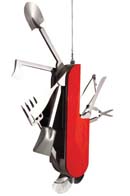In his cult text “The Sufficiently Good Artist: Beyond the Avant-Garde Artist,” Donald Kuspit hurt for forever more the pride-swollen megalomania found in that kind of artist. Kuspit stripped the histrionic narcissism of the two basic typologies the avant-garde artist used to express himself: the assumption of social reeducation and the persona-making he finds in suffering a shield to shun the world, to open up the gates to the world. The theoretician explained abundantly the strategy of reversion/self-legitimization that timely trails the avant-garde artist: to wound the Academy, to demonize everything reeking of institution and order in a bid to get access –by the hand of the time that rules the lack of moderation– to the institution, the comfort and the Avant-Garde Academy. That’s a pathetic paradox. The first thing a post avant-garde artist tries to weed out for good is the neurosis his predecessor carried to the level of psychosis. Kuspit, and not only Kuspit –nobody is such a fool ‘cause everybody knows which side the cat actually jumps on– noticed the avant-garde artist used to exploit a neurotic empathy with the world. An antipathy that never stopped being empathic, of course. Being a full-fledge avant-garde artist required a determination to challenge and disaffirm the world –better yet, the social environment– and that black monster called the market. Those were the two ways of being at ease, from the bottom of their hearts, with the market and, therefore, with the world. The two exact proceedings to channel the avant-garde wrath and rebel character –two gifts they boasted like chevrons– were iconoclasm –the apology of rupture, called “linguistic Darwinism” by Bonito Oliva– and suffering. The pathetic treatment of suffering, the dramatic withdrawal from the fold, from the bohemia that never gives in to any concession that might lead to a pact with social and mercantile order. The swollen chest, the ripping of the clothes in the first public square, the body of the avant-garde artist as a recipient of torment. The avant-garde artist, the one who is “good enough,” wants to jump from that self-indulgence in disguise to rebelliousness. He understands that negotiation is not synonymous of capitulation, just like adaptability doesn’t necessarily imply concession. The one “good enough” acquires a safety that allows him to negotiate and try to get certain level of adaptability with the world, construed as an intimate relationship with him that never stops being critical, reflexive, though not –not that- pathetic, totalitarian and opportunist. The “good enough” tries to find his spot in the world, outside avant-gardism’s hassle-free formulas. Then he realizes there’s an ongoing uphill battle in a highly competitive world where, just like him, there are hundreds of “good enough” people who can’t find the previous alibi of suffering or mass reeducation. The competition is for high stakes, armed with talent, exclusiveness and marketing professionalism, yes sir. The last line above reveals a couple of problems. First, how in the world can anyone get an exclusive image in a time when the myth of originality is gone and is now nothing but an outdated, chuffed ghost? In a cannibal world in which culture operates like as thick and interacting tissue, in which everybody has a little bit of everybody else, and in which plagiarism has grown to become a typology of text-exchanging, how can the market networks be intercepted? What’s the right image to do that? Euphemism pops up then as the healing potion: singularity is the name of the game. Singularity is a soft, undamaging term that messes with nothing or nobody. You can’t be self-conceited about originality because it would turn out ridiculous, outdated, like a canned dinosaur. You have to be singular in a time when codes are not biased, but they really are emptied by overspill. What does this mean? There’s been a tad of everything: modernity, post-modernity, critical continuation of modernity, avant-garde, neo-avant-garde and trans-avant-garde. So, now what? As Cuban band Van Van sings, what comes after all? I sleep alone while you jump from bed to bed. From esthetic code to esthetic code. There was figurative and abstract painting, mediations, interflows, zillions of figurative and abstractive variants, mountings, collages and de-collages, conceptualism and post-conceptualism, a return to fascination and contemplation, logo-centrism and the crisis of logo-centrism; short-lived art and irony in memory relocation; reproduction and crisis of the unique work’s aura, democratization of culture, and the comeback to techniques that are up to no good with perdurability and significance; expressionism and neo-expressionism; the tampering with and re-contextualization of the object had no problem whatsoever in becoming a sacred, museum-oriented and marketable thing; installation is today a form of expression as “traditional” as painting and photography. A performance comes naturally on a daily basis. In this scenario of plurality and cycles, of a coexistence that attempts to be peaceful, the notion of repertoire calls the shots. Not the one attached to trends or hegemonic currents, but the one related to the esthetic and linguistic repertoire; modalities of artistic expression. The artist has at his disposal a vast repertoire of historically-proven possibilities, and he must put his luck through its paces when blending all that –or parts of all that- in a singular way. That bevy of possibilities, of course, every so often pushes the panic button. How are hierarchy and decanting –so necessary, no matter how unpleasantly modern they might sound- brought off amid a competition of talents sufficiently prepared to cope with the ups and downs of the market? It’s then when media and mediations play a major role. As a matter of fact, they either wield or rub out judgments of value that become overwhelmingly decisive. The market and the critics do far more than what they’re asked to, they do their own and what they didn’t do in the past. The former rather than the latter, to be honest. If critics don’t hold an international status as competent curators, then words are words, adjectives are adjectives, and interpretations are nothing but interpretations. The curator or organizer capable of picking up the centers of artistic power –displaced, ever-changing, but still standing there with some mightiness of their own- becomes the highest man on the totem pole. The dealer and the representatives, next to the curator or organizer, the director of art galleries and major museums, of biennials, set both the tone and the pace of the contemporary art. They do the outlaying and the mapping out. It’s an unfair fight. The “good enough” artist must make use of his kindheartedness to seduce, not the competent connoisseur or the demanding institution, but the network that flows into the mainstream. He ought to be in the right place at the right time, be willing to quench the thirst of distinction that might drive the higher bidders. We look for “narrative painting” or “progressive videos,” and let it all hang out. It’s good not to leave anything unsaid, but sometimes one thing leads to another: the higher bidder, in terms of cultural capital, is a portent of professionalism. Many people are talented who, as blind as moles, go out there everyday to compete, just to see if good things will come his way sooner rather than later. This has been the price to pay for freedom. There are not so many esthetic tyrannies out there. You don’t have to do pop, hyperrealism or conceptualism, come up with a new figuration or neo-expressionism to get there. Not necessarily. You can do anything for as long as you want to. All you need to be is a “good enough” artist, work wisely and bide your time. Pathetic feelings and reeducation don’t pay off anymore. You have to fight with pure, genuine quality, without political or sentimental clutches. How is quality gauged? How can be read? How can be calibrated or valued? The price of freedom is too high. Many artists fall by the wayside as part of this dog-eat-dog, sordid competition. Now you do have to fight with might and main. Does the abuse stop here? Now at a time when legitimate splendor depends more on qualitative reasons aloof from opportunist stances, value and collocation hinge less on the artwork itself and more on its context and legitimizing stakeholders. It looks like a dirty trick, an irony of fate. The tide is high now and the stakes are even higher. Nonetheless, you still chance upon someone cocky enough to keep the avant-garde ball rolling, someone who believes the “alternative” or the “experimental” –those bitter aftertastes on the adolescence borderlines– can clinch a success; or a performer who tries, with just an action, to disarray order or disorder; or a high-handed arrogant who wants to jeer at people’s emotions since cynicism continues to hand out –it’s said- passports to the avant-garde move. The only thing that’s left to do now is to give a hint of a smile and keep fighting on the ground. Today everything is far more complicated than the avant-garde gesture of the last –and drunk– bohemian.


Related Publications

How Harumi Yamaguchi invented the modern woman in Japan
March 16, 2022
Giovanni Duarte and an orchestra capable of everything
August 26, 2020











